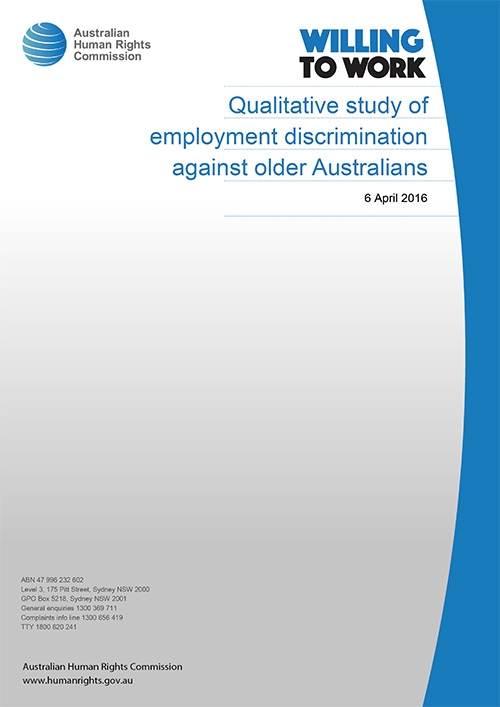Qualitative study: Employment discrimination against older Australians

EY Sweeney
(EY Sweeney Ref No. 25397) – 6 April 2016
EY Sweeney Report disclaimer:
This report was prepared at the request of Australian Human Rights Commission (hereafter “the Client”) solely for the purposes of performing quality research to the experience and impact of the age related employment discrimination against older Australians as part of the Willing to Work Inquiry and it is not appropriate for use for other purposes. Any party other than the Client who accesses this report shall do so for their general information only and this report should not be taken as providing specific advice to those parties on any issue, nor may this report be relied upon in any way by any party other than the Clients.
In carrying out our work and preparing this report, Ernst & Young has worked solely on the instructions of the Clients, and has not taken into account the interests of any party other than the Clients. The report has been constructed based on information current as of [date], and which have been provided by the Clients. Since this date, material events may have occurred since completion which is not reflected in the report.
Ernst & Young, nor the parties which have endorsed or been involved in the development of the report, accept any responsibility for use of the information contained in the report and make no guarantee nor accept any legal liability whatsoever arising from or connected to the accuracy, reliability, currency or completeness of any material contained in this report. Ernst & Young and all other parties involved in the preparation and publication of this report expressly disclaim all liability for any costs, loss, damage, injury or other consequence which may arise directly or indirectly from use of, or reliance on, the report.
Liability limited under a scheme approved under Professional Standards Legislation.
Management summary
In 2015 the Australian Human Rights Commission engaged EY Sweeney to conduct qualitative research to supplement the 2014 quantitative national prevalence survey. The overall objective of this study was to explore the experience and impact of employment-related age discrimination amongst older Australians.
The study included 52 depth interviews with older workers aged 50 years and over and 5 focus groups with managers both of whom had participated in the quantitative survey. The fieldwork was conducted between 3 December, 2015 and 3 February, 2016 across metropolitan and regional locations in Victoria, New South Wales, Queensland, South Australia, Western Australia, Tasmania and the ACT.
The key findings
There are a number of factors that frame the individual experience of age discrimination. These factors represent long standing social perspectives and macro industry dynamics, and are beyond the control of the individual. They include the limiting attitudes and beliefs around ageing and work life, the business dynamics and economic demands pushing for continued productivity and profit and driving a trend toward transient workforces, the individuals’ personal capacity to cope (resilience), through to the language that of optimism and energy that appears to be strongly and selectively associated with the younger worker.
These factors establish circumstances (structural, social, attitudinal) where age discrimination can more readily occur.
Age discrimination experience
Just as age discrimination occurs in a context, it also cannot be defined as a single type of experience. This study revealed four key types of age discrimination that stretch from the point of recruitment to workplace settings whereby the end result being excluded from the workplace through to having diminished opportunity:
1. Shut out… Recruitment: unable to get an interview or secure a position
2. Pigeon holing… Workplace: becoming stuck or constrained in their role
3. Structural… Workplace: being targeted for redundancy or restructure
4. Cultural… Workplace: subject to discriminatory culture or management practices
Each of these experiences was characterised by different behaviours and outcomes. Some behaviours clearly presented overt age discrimination:
- Targeting older groups for redundancy
- Clear intent to manage out an individual despite performance and expertise
In many instances, the experience was the result of more subtle and indirect age discrimination, for example:
- The interest expressed in an applicant which fades once their age is apparent
- The passing comments, made in jest, that implied the worker was old or out of touch
- The assumption that the older worker would not be able to understand technology
- The lack of consideration for training opportunities and new projects
- Not being ‘taken seriously’ for a promotion.
Consequently, in most scenarios, older workers either tolerated the experience or chose to move on. It was rare they took any formal action as the age discrimination was considered too difficult to prove. This reluctance was compounded by the perceived risk of taking action to no avail, and subsequent fear of being saddled with the tag of ‘trouble maker’.
Impacts
The impacts of age discrimination in employment were very real for older workers. Whilst some could ‘dismiss’ the experience and ‘learnt’ to tolerate, it could also have a profound impact. The degree of impact was influenced by: the scale of the incidence, whether it was one off or a constant occurrence, the older worker’s sense of security in the workforce overall, their personal resilience and what they felt was at stake.
Age discrimination had the capacity to affect all aspects of an older worker’s life, resulting in financial, personal, working life and emotional impacts. Ultimately the impacts of age discrimination diminished the individual, and had direct bearing on their current and future productivity, as many ultimately started to question their longevity in the workplace.
Barriers
The barriers to older workers within the workforce and recruitment process were apparent at both an organisational and individual level. Arguably, there were incidences where older workers may have reflected negative social stereotypes, and therefore helped to establish or reinforce barriers themselves.
From an organisational perspective, there were two dominant barriers apparent. Firstly, there was a perception that older workers could be more costly to a business due to the diminishing value of their skills and experience relative to their salary; and secondly, a bias toward older workers based on negative stereotypes such as, they: lacked the hunger to progress, had less energy and enthusiasm than their younger counterparts, were close minded and inflexible with an inability to embrace ideas or change and could struggle with technology.
Barriers were also apparent via sector bias (i.e. where specific industries positioned themselves as more ‘youth’ orientated), the challenges displayed by younger managers as they struggled with or actively avoided engaging with older workers, workplace isolation from being ostracised by colleagues and, as suggested by some HR managers, organisational structures that ‘unwittingly’ resulted in age discrimination.
Older workers were not always without responsibility in this regard. In some instances, older workers can also create barriers through manifesting some characteristics that align with the negative stereotypes or presenting as being deliberately difficult.
The recruitment process also presented significant barriers to older workers. The professional risk that HR managers and recruiters associated with making a poor employment decision and the desire to ensure some tenure in the new recruit both worked to the disadvantage of older workers. Moreover, older workers finding themselves seeking employment for the first time in a long period, said that their understanding of recruitment processes and job interview skills were 'out of date'.
Solutions
To address age discrimination in employment comprehensive solutions are necessary. Solutions need to involve engagement of all parties including community, organisations, recruiters and workers.
A fundamental requirement is the necessity to shift the stereotypes and misconceptions around older workers, their capacity and capability and inspire a more positive understanding and appreciation of the older worker.
Education and awareness solutions ranged from broad discussion, communications campaigns, social initiatives to break down intergenerational barriers through to targeted campaigns for the business sector.
Training was considered an essential requirement to shift attitudes and behaviours, specifically amongst HR managers and recruiters through to managers that supervise older workers. Older workers also need training on career planning and skills development in regards to recruitment and transitioning into new employment.
Given the challenge faced by older workers, an advice line (to provide objective support and assistance to those encountering age discrimination) and dedicated recruitment services (to work with recruiters who genuinely understand and appreciate the value of older workers) were also suggested as solutions that should be considered.
To motivate change, in a relatively timely fashion, a clear focus is required on organisations, including recruitment and management practices. Although incentives or penalties can be employed to encourage corporate compliance, for genuine progress, it has to be recognised that businesses are unlikely to pursue activities that are in conflict with their broader organisational goals. Older workers need to be viewed as fit for purpose and able to effectively contribute to the needs of the organisation. In some instances, this may not be feasible, in others it may be a matter of more flexible work practices or new ways of working that recognise different life stages, whilst in others it may require a change of attitude.
Although some progress may well have been achieved in that overt age discrimination is less prevalent, the current challenge is to shine a light on the subtle behaviour and bias that result in age discrimination. To continue to challenge that organisational decision making and behaviour is based on the older workers’ actual capability and potential rather than an assumed diminished state.



